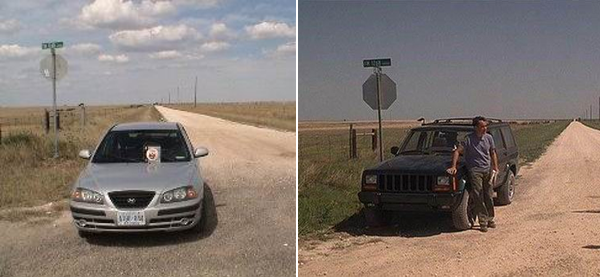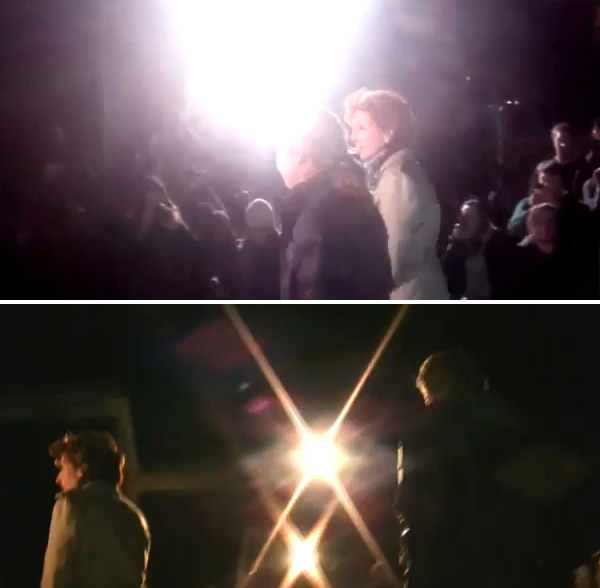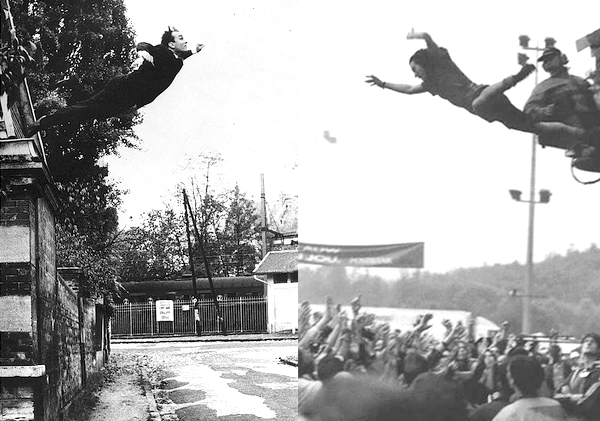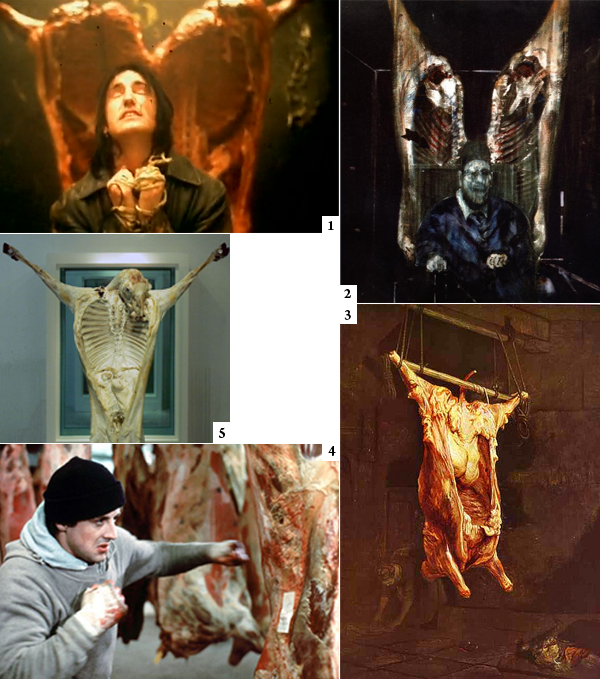Towards a Middle of Nowhere

Texas
In 2006, six years after Cast Away was released, a man named Doug Mathieson drove his Hyundai to N 35° 38.036 W 100° 27.076 — an intersection approximately 15 miles south of Canadian, Texas, by the Oklahoma border — and got outside, rested Wilson (a volleyball adorned with a red hand implicating the events of said film) on the hood of his car, and took a photo of it with the intent of commemorating both the film and his commemoration of it. Having not been anywhere near where he’s talking about, your contributor has Google maps displayed on another tab, the flat beige America honoring the endless wheat, the little orange man severely sun burnt from the forever high noon sun. In a description from which said photo was culled, Doug endearingly says, “Cast Away has one of my favorite Movie endings where Chuck Noland (Tom Hanks) is at the ‘crossroads’ of his life deciding what he will do now with the rest of his life.” I imagine Doug in his early forties, probably married and with an o.k. life, with maybe a little too much time on his hands.
ToBS R1: “everybody has a story” vs. “show don’t tell”

[Matchup #9 in Tournament of Bookshit]
“Everybody has a story”
But I don’t like the story of a woman unsatisfied with her marriage, her greying hair still shoulder length from the 60s, taking a creative writing class at the community college, getting all nervous in her Hyundai parked outside under a leafless tree, going over in pen, again, the final revisions of her 3000-word story: the one about a woman her age, of average median household income, whose husband is also a strong but silent type reoccurring satellite figure in her empty life; who, like the amateur in jean overalls now crying in her Korean-made car, also drinks gin in her pajamas at night while playing solitaire, in an unnamed though evocatively New England-y town, whose racial demographic is similar to hers, except in the story the friendly mail man who dies of cancer because something needs to fucking happen is African-American, which her instructor (a man with both a novel and pony-tail “out”) told her she should include before she submits it to Glimmer Train, because those ladies are into black guys probably. READ MORE >
Teenwolf as Kafkian Experience

Teenwolf (1985) begins with the muffled sound of a basketball in place of, or competing with, a heartbeat — that of Scott Howard (Michael J. Fox), a lanky self-conscious high school student trying his very best at basketball. The conquest of men, drained of blood and necessity, finds its charade in contemporary American sports. The opening scene is shot from below, with Scott’s head prophetically eclipsing the round lunar overhead stadium light. Despite the brief elevated pulse, we see Scott under his pallor, unwittingly negotiating the complexities and politics of the external world, tightly mapped out on a basketball court. Comparisons to Goethe’s Young Werther, Salinger’s Holden Caulfield, and Dostoyevski’s narrator in Notes from the Underground are likely, though we all know the imminent metamorphosis into wolf (i.e. the postmodern “other”) is essentially Kafkian; thus, Teenwolf preserves the legacy of Kafka’s The Metamorphosis as the grotesque as metaphor for perceived self-deformity and body dysmorphic disorder. One may note, or at least this contributor, the inverse-POV angle of Scott looking at us from above, intent on our gaze, sweaty, as if we, or the cameraman, were fellating the young actor; though the space between these two orientations is collapsed by the camera’s super-consciousness, its pictorial convex sweep bestowed with omniscience, as if we, void of God, were desperate to find its robotic mascot. Hey boy, big boy, we think under muffled vowels at the film’s opening shot. It seems the director, in an act of cinemagraphic authority, has been careful to put us into place.
Angles

On November 22, 2011, at approximately 2:05 PST, at the time of this post’s inception, a version of UC Davis Chancellor Linda Katehi walking to her car (with the parenthetical “higher quality,” as proposed by the uploader) had been viewed 873,526 times three days after it had been posted. Its like-to-dislike ratio was 4485:91 (or, ~49:1). It captures the 2:39 minutes endured by Katehi and relished by us all for her to walk to her car through a considerate berth of protestors, silenced in their greatest form of protest. This is when I began to take them seriously. It is one of the most beautiful things I’ve seen, in its humanity, restraint, and ultimate respect for another human being. Of course, we understand that Katehi is being publicly shamed, and judged, and the silence is indignantly rhetorical. A less popular version, shot from another angle, its camera operator incessantly “a little behind” and somewhat crouched, had, at the same point in time of this composition, 98,064 views, with a ~55:1 like-to-dislike ratio. Although it is parenthetically and ostensibly “HD, best quality,” it will forever remain a subordinate version of the greater version, the latter’s historicity democratically bestowed by the aesthetic inclinations of the people: they preferred the perpendicular “real time” camera angle, the purplish fragmented light and sporadic halos caused by an array of camera flashes perhaps heightening this eerie inverse Coronation of the Queen. Media accelerates history, and it seems Katehi will go down as the Chancellor of a large liberal California University who was to be held responsible for the violent assault by her police on her civilly disobeying class; and all the PR letters from the Chancellor’s office carefully crafted by administrators with Master’s degrees to both justify and mitigate, could not assuage the gross verity of pepper-spray being casually administered on a group of solemn protesters, whose imminent tears would be heard over cameras, some of them held by the protesters themselves, as they shook and writhed towards vertigo — all emitted through the quicksand of memory known as the internet, in truncated and fragmented versions of the same event, each vying for a piece of history. Sometimes it is difficult to ask a question when the reward of silence has just commenced. What would you have done? I don’t believe there are good people and bad people, and a line in between. That would assume I’m on the right side, and my world ends the moment I believe that. This post is an elegy for seeing things from another angle.
Song for Bob Dylan

In 1988, I spent my month’s allowance on Guns n’ Roses’ “Appetite for Destruction,” and was unwittingly yet gleefully met by a stunning illustration on the inside cassette flap of a disoriented woman having just been sexually assaulted or raped. At 12 years of age, I think I understood the sociopolitical significance of the image — that it was “bad”; that rape and physical violence towards women was “bad”; that a hard rock band had a vested economic interest in conveying the image of themselves as “bad,” yet there was still a part of me, perhaps the majority, that simply, essentially, found the cotton stretched panties and exposed plump breast extremely erotic. I may have even unsuccessfully masturbated to the picture; I kept saying “this is a cartoon” to myself as I eventually grew flaccid. More than two decades later, today, knee-deep in Occupy Wall Street media k-hole, I came across a picture of a young protester, perhaps in need of some originality, reading a book that could be anywhere from Twilight to Chomsky’s greatest hits. And guess what I thought? What image immediately came into my mind. I know this is “bad,” that my adult male brain has been hijacked and permanently fucked by the images, album covers, videos, proposed by “bad” rock n’ roll boys who ostensibly were writing songs about how I felt, my unsettled and unsettling emotions, somehow, somewhat, probably not. David Bowie’s “Song for Bob Dylan” (1971) offers the lyric you gave your heart to every bedsit room / at least a picture on my wall / and you sat behind a million pair of eyes which honors Dylan’s voice as being that of his generation. Decades only happen once, but they take ten years to happen, and that is a enough time to get bored. I was born already tired of the 60s. Children dream of perfect worlds, and adults resent and lament the missed opportunities. It is touching, really. This slow dance between frowning parties that never ends. Cobain is dead, and Bieber’s voice is still of a eunuch’s, so maybe our reposed protester can only settle for a sign printed in caps, a sign she doesn’t hold, but places between her legs.
A void

In 1960, Yves Klein set a tarpaulin on the street, leapt off a building onto it, later altered the photograph to make it all seem cooler, and called it “Le Saut dans le Vide (Leap into the Void).” No one expects the artist to have hurt himself in the making of said image, so we’ll give him the haha-ok nod. Of his other works, my favorite, is “Le Vide (The Void)” (1958) in which he showed an empty display case in an empty gallery in order to present nothing; of course, somewhat unfortunately, the presence of the display case in itself was necessary in invoking the theoretical absence of what might have been there. On the opening night, 3000 classy Parisians waited in line outside waiting to be let into the empty room. Some 30 years later, a then-disgruntled singer of a rather popular grunge band leapt off a stage set into his fans, lending an Olympic component to the “stage dive.” The fans braced the imminent collision with extended hands, together in a mutual crowd wave which I’ve always found endearing. To carry your fallen hero back to the alter is well worth the ticket, and chance of a sprained wrist. If the acceleration of gravity is godless physics, then the assumption that your fans will catch you is faith in one’s art. For your own personal Klein painting, this contributor encourages you to google map any of our vast oceans (zoomed in, satellite view); or, in his avoidance of work, this.




